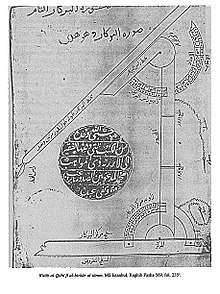Ibn Muʿādh al-Jayyānī
| Al-Jayyānī | |
|---|---|
| Born |
989 Cordova, Al-Andalus |
| Died |
1079 Jaén, Al-Andalus |
| Residence | Caliphate |
| Academic background | |
| Influences | Euclid, al-Khwarizmi |
| Academic work | |
| Era | Islamic Golden Age |
| Main interests | Mathematics, Astronomy |
| Influenced | Alfonso X |
Abū ʿAbd Allāh Muḥammad ibn Muʿādh al-Jayyānī[1] (Arabic: أبو عبد الله محمد بن معاذ الجياني;989, Cordova, Al-Andalus – 1079, Jaén, Al-Andalus) was a mathematician, Islamic scholar, and Qadi from Al-Andalus (in present-day Spain).[2] Al-Jayyānī wrote important commentaries on Euclid's Elements and he wrote the first known treatise on spherical trigonometry.
Life
Little is known about his life. Confusion exists over the identity of al-Jayyānī of the same name mentioned by ibn Bashkuwal (died 1183), Qur'anic scholar, Arabic Philologist, and expert in inheritance laws (farāʾiḍī). It is unknown whether they are the same person.[3]
The book of unknown arcs of a sphere
Al-Jayyānī wrote The book of unknown arcs of a sphere, which is considered "the first treatise on spherical trigonometry",[4] although spherical trigonometry in its ancient Hellenistic form was dealt with by earlier mathematicians such as Menelaus of Alexandria, who developed Menelaus' theorem to deal with spherical problems.[5] However, E. S. Kennedy points out that while it was possible in pre-Islamic mathematics to compute the magnitudes of a spherical figure, in principle, by use of the table of chords and Menelaus' theorem, the application of the theorem to spherical problems was very difficult in practice.[6] Al-Jayyānī's work on spherical trigonometry "contains formulae for right-handed triangles, the general law of sines, and the solution of a spherical triangle by means of the polar triangle." This treatise later had a "strong influence on European mathematics", and his "definition of ratios as numbers" and "method of solving a spherical triangle when all sides are unknown" are likely to have influenced Regiomontanus.[4]
See also
Notes
- ↑ Latin forms include Abenmoat, Abumadh, Abhomadh, or Abumaad, corresponding to either Ibn Muʿādh or Abū ... Muʿādh.
- ↑ Calvo 2007.
- ↑ Dold-Samplonius & Hermelink 1970.
- 1 2 O'Connor, John J.; Robertson, Edmund F., "Abu Abd Allah Muhammad ibn Muadh Al-Jayyani", MacTutor History of Mathematics archive, University of St Andrews .
- ↑ O'Connor, John J.; Robertson, Edmund F., "Menelaus of Alexandria", MacTutor History of Mathematics archive, University of St Andrews . "Book 3 deals with spherical trigonometry and includes Menelaus's theorem."
- ↑ Kennedy, E. S. (1969), "The History of Trigonometry", 31st Yearbook, National Council of Teachers of Mathematics, Washington, D.C.: 337 (cf. Haq, Syed Nomanul, The Indian and Persian background, p. 68 , in Seyyed Hossein Nasr, Oliver Leaman (1996), History of Islamic Philosophy, Routledge, pp. 52–70, ISBN 0-415-13159-6 )
References
- Calvo, Emilia (2007). "Ibn Muʿādh: Abū ʿAbd Allāh Muḥammad ibn Muʿādh al‐Jayyānī". In Thomas Hockey; et al. The Biographical Encyclopedia of Astronomers. New York: Springer. pp. 562–3. ISBN 978-0-387-31022-0. (PDF version)
- O'Connor, John J.; Robertson, Edmund F., "Abu Abd Allah Muhammad ibn Muadh Al-Jayyani", MacTutor History of Mathematics archive, University of St Andrews .
- Dold-Samplonius, Yvonne; Hermelink, Heinrich (1970). "Al-Jayyānī, Abū'Abd Allāh Muḥammad Ibn Mu'ādh". Complete Dictionary of Scientific Biography. Encyclopedia.com.
